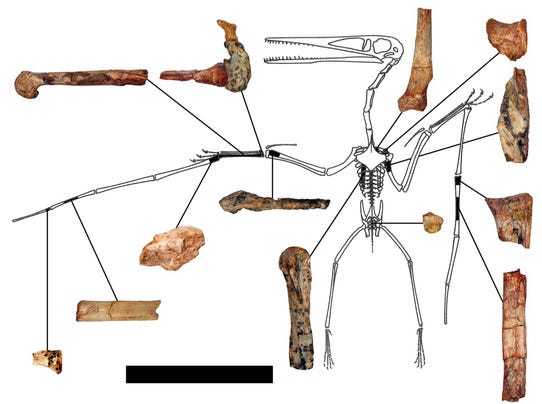 Scientists say they've discovered the oldest, most primitive member
of a family of flying reptiles that ruled the Cretaceous skies. The find
has raised controversy, but even critics agree it could help shed light
on how these beasts became the kings of the air.
Scientists say they've discovered the oldest, most primitive member
of a family of flying reptiles that ruled the Cretaceous skies. The find
has raised controversy, but even critics agree it could help shed light
on how these beasts became the kings of the air.The species dates back 163 million years, making it the earliest known representative of the most important lineage of pterosaurs, winged creatures often referred to as dinosaurs though they aren't actually. Many of the pterosaurs that came later were enormous, flamboyant or both. The new pterosaur was, at best guess, a plain fellow of modest proportions.
"His wings were only about 4½ feet wide, so he had a smaller wingspan than I do," says University of South Florida paleontologist Brian Andres, leader of the team reporting the find. "From what we can tell, he was a small, unimposing guy. But out of small things, big things sometimes come."
The fossil of the animal was discovered in northwestern China in a remote region near the Gobi Desert where summer temperatures reach 125 degrees and snow is liable to fall in September. The scenery was a backdrop for the movie Crouching Tiger, Hidden Dragon, prompting the scientists to sneak a film reference into the new animal's scientific name, Kryptodrakon progenitor. "Kryptodrakon" means "hidden serpent," and "progenitor" means "ancestral" or "firstborn." In Kryptodrakon's day, rivers, ferns and trees dotted the now-barren area, and Andres speculates the animal dined on insects or fish.
Kryptodrakon may not have been the most impressive reptile on the block, but its age and place in the pterosaur family tree make up for its lack of flash. Pterosaurs had been around for 60 million years when a new type of pterosaur elbowed its way onto the Jurassic scene. These newcomers, known as the pterodactyloids, were a radical departure from their predecessors. They had longer skulls and shorter tails than the primitive, old-school pterosaurs; even their brains were different. The geezer pterosaurs soon went extinct. The Johnny-come-lately pterodactyloids prospered, evolving into about 150 wildly diverse species. The biggest pterodactyloids rivaled small airplanes in size, while the fanciest bore crests that resembled towering mohawks and unfurled sails.
"They take over the skies and they become the largest flying organisms we know of," Andres says. "They were large, and they were in charge."
Scientists haven't known much about the origins of the pterodactyloids, and Kryptodrakon may help. It's the earliest known pterodactyloid, Andres and his colleagues say in this week's issue of Current Biology, predating the next oldest of its kind by about 5 million years. The scientists say Kryptodrakon's body plan shows that one of the clan's secrets to success was an extra-long bone attached to the "wing finger," which served as the scaffolding for the animal's wing membrane. That longer bone allowed the pterodactyloids to try out a wide variety of wing shapes for navigating different habitats. The scientists concluded, based on an analysis of the entire pterosaur family tree, that pterodactyloids arose in inland habitats, in contrast to more primitive species, which were mostly creatures of the sea and the coast.
Outside opinion is mixed. Paleontologist David Hone of Queen Mary University of London says he has no doubt that Kryptodrakon is a new species from a crucial time period, and the new study makes a "convincing case" that pterodactyloids arose away from the sea.
David Unwin of Britain's University of Leicester worries that the "fossil" may actually be a mix of bones from more than one animal. He says that even if the fossil is all of a piece, it may not be a pterodactyloid at all but a more primitive pterosaur. Andres responds that the fossil is definitely a pterodactyloid and definitely belongs to only one animal.
"It's going to be a very contentious fossil," predicts Unwin, author of a book on the pterosaurs. "But it will still be very interesting in terms of our understanding of pterosaurs. … It's a good thing we have the fossil."
No comments:
Post a Comment